|
s we can see during the short reign of a decade of King Joseph II significant concessions were made for the Lutheran community in Hungary. The Edict of Tolerance was entirely based on the King’s grace, so it was formally codified by Joseph’s successor, King Leopold II: the formal codification was set forth in Article 26 by the National Assembly (Parliament) in
1791 proclaiming the freedom of religion. At Whitsuntide the congregation in Pest expressed its thanksgiving at a ceremonial service to the Lord for another token of divine providence. Conductor Bengraf’s ceremonial Cantata, composed for the occasion, was performed in the prayer hall packed with believers. Later the Cantata was also printed.
The prayer hall gradually proved to be too small for the congregation, so the time came for the establishment of a permanent property, a church. During the Synod that gathered in autumn 1791 a proposal was submitted for the establishment of a permanent home, that is a site, a parochy, a church and a school.
A decisive meeting was arranged in Mrs. Beleznay’s palace in Pest in November 1791. Péter Balogh, General Inspector of the Lutheran Church (23) invited to the meeting not only the presidium of the congregation, but also the military commander of Buda and Pest, Brigadier General Josiás Coburg (24), who was a Lutheran. He acted as an intermediary between the congregation and the Royal Court, as a result of which the Lutheran Church filed a request for the transfer of ownership of the military courtyard used for storing wood of the Invalidus, in other words the Grenadiers’ Barracks (25) built by Charles III and owned by the Treasury to the Lutheran Church for the purpose of a site for a church and a school. Minister Molnár personally handed over the request document to the successor of King Leopold II, Emperor Franz I, when Franz was crowned King of Hungary in Buda in spring 1792. The Governor’s Council granted approval, and the town management and the Lutheran leaders signed the contract in October 1792 (26).
In possession of the documents for use, members of the congregation visited the sight. They were surprised to see that
Johanna Schmallöger
 , who was in charge of a theatre in Vienna, rented the area for the purpose of an arena, a so-called Hetz-Theater, where animal fights were arranged. The site was situated outside the fortification walls of the town, and was also used for the purpose of weekly markets, therefore it was also called "Káposztás piac" (Cabbage Market), in German Kohlmarkt. It was not made any more attractive by a military bakery situated nearby. , who was in charge of a theatre in Vienna, rented the area for the purpose of an arena, a so-called Hetz-Theater, where animal fights were arranged. The site was situated outside the fortification walls of the town, and was also used for the purpose of weekly markets, therefore it was also called "Káposztás piac" (Cabbage Market), in German Kohlmarkt. It was not made any more attractive by a military bakery situated nearby.
So the Lutheran community in Pest found its site outside the crumbling stone walls of the town along a dusty highway. Due to the lack of finances they could not even think of constructing a church for the time being. They had to make do with the plan of their leaders according to which a young architect, János Krausz, who was invited to do so by the leaders, made plans for a temporary prayer house and parochy (48-49). The plans were approved, the Hetz-Theater was demolished, and soon a nice, new building was erected on the derelict, abandoned site. From the front wall of the one-storey building, where the
Lutheran Museum
 stands today, five windows looked onto the site, and it was in this house, where songs and prayers praising the Lord were chanted, and the Word of God was pronounced for the first time on 20th May 1794. The congregation finally moved to this building after seven years, and the building served for 17 years as a spiritual home for the Lutheran community until their church was built. A year later the building was extended by an upper floor to provide homes for the minister and the cantor. stands today, five windows looked onto the site, and it was in this house, where songs and prayers praising the Lord were chanted, and the Word of God was pronounced for the first time on 20th May 1794. The congregation finally moved to this building after seven years, and the building served for 17 years as a spiritual home for the Lutheran community until their church was built. A year later the building was extended by an upper floor to provide homes for the minister and the cantor. |
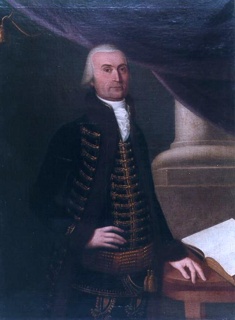
(23) Peter Ócsai Balogh
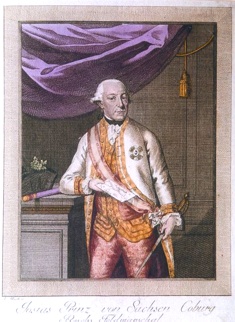
(24) Jósiás Coburg
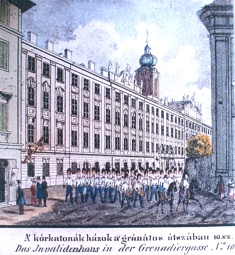
(25) Military courtyard
|
|
The leaders then set out to collect money for the construction of a church. First they composed a letter of claim, which was also printed later, to their brethren in faith abroad describing in detail the history full of hardships and also the difficult present situation of the congregation (31). In this letter they requested that their brethren transferred their donations, if permitted by Prince Coburg, to the exchange office of the Prince. Due to wars in Europe, they received small donations with the exception of those from the congregations in Hamburg and Württemberg, which allocated significant donations.
Following this the leaders filed a request to the domestic congregations to say that with their donations…"they should act to the glory of the Lord, to spread knowledge on the truth and to make the faith enrich and flourish" (32,
33). As a result of the request 17,000 Rhinal Forints was donated (the equivalent of about 1 million Euro), of which Countess Beleznay alone donated 10,000 Forints (approximately 120,000 Euro). Architect Krausz prepared the plans for the church (34). He designed a facade with a spire of medium height and Corinthian columns to decorate the House of Lord. The 37 year-old architect, who suffered from tuberculosis, died two years later, in 1798.
Providence however came again with a helping hand in the person of young
Mihály Pollack  (36) to assist Krausz’s young builder-in-charge. Pollack, a young genius of an architect, was destined to make the old dream of the Lutheran congregation come true. Born by the second marriage of an Austrian architect, Joseph Pollack, Mihály Pollack came to Hungary at the age of 25 after a study tour in Italy. Krausz, who designed the church, employed him as an assistant. They had hardly started working together, when Krausz died. Pollack filed an application to Council of Pest for admittance to the Guild of Architects in Pest. Although Krausz’s widow was willing to transfer her late husband’s master’s right to young Pollack, the young architect was granted a citizen’s pass in Pest after a long series of wrestling with the local bureaucracy. The congregation assigned him with the task of developing the final plans for the church. In those days nobody thought that Mihály Pollack, who stayed in Pest until he died at the age of 82, and who later became world-famous, would design a further 193 buildings, among them the building of the Hungarian National Museum.
(36) to assist Krausz’s young builder-in-charge. Pollack, a young genius of an architect, was destined to make the old dream of the Lutheran congregation come true. Born by the second marriage of an Austrian architect, Joseph Pollack, Mihály Pollack came to Hungary at the age of 25 after a study tour in Italy. Krausz, who designed the church, employed him as an assistant. They had hardly started working together, when Krausz died. Pollack filed an application to Council of Pest for admittance to the Guild of Architects in Pest. Although Krausz’s widow was willing to transfer her late husband’s master’s right to young Pollack, the young architect was granted a citizen’s pass in Pest after a long series of wrestling with the local bureaucracy. The congregation assigned him with the task of developing the final plans for the church. In those days nobody thought that Mihály Pollack, who stayed in Pest until he died at the age of 82, and who later became world-famous, would design a further 193 buildings, among them the building of the Hungarian National Museum.
|
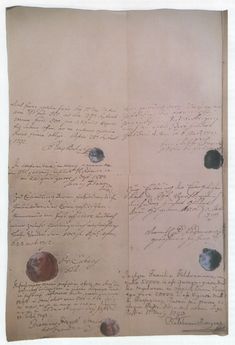
(33) The request
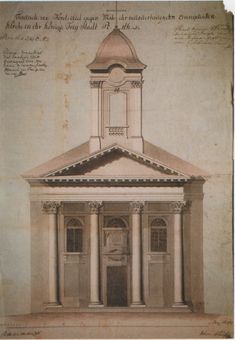
(34) Churc plan of János Krausz |